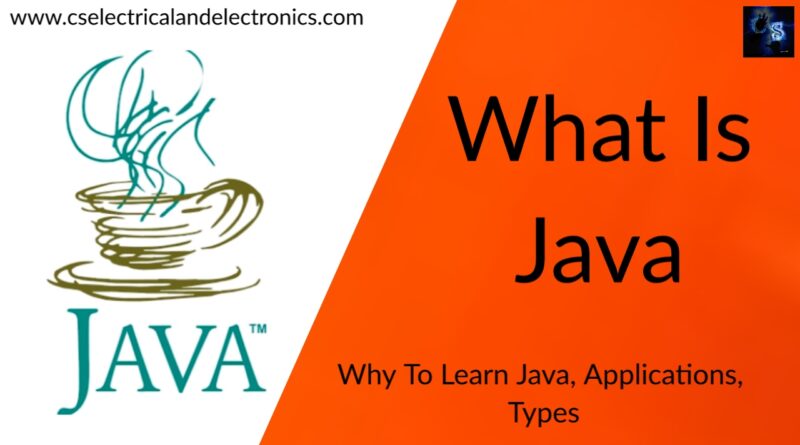What is JAVA, Applications of JAVA, History, Code On Java
Hello guys, welcome back to my blog. In this article, I will discuss what is Java, the applications of Java, its history, examples of it, how to get started with it, different types of versions.
If you have any doubts related to electrical, electronics, and computer science, then ask question. You can also catch me @ Instagram – Chetan Shidling.
Also, read:
- 100+ C Programming Projects With Source Code, Coding Projects Ideas
- Top 10 Applications Of C++ In Different Domains, Cpp Applications
- Applications Of Artificial Intelligence, AI Applications, What Is AI
This core Java tutorial is designed for students as well as for working professionals. Java is an object-oriented, concurrent, class-based, secured, general-purpose programming language. It is a broadly used robust technology.
What is Java?
Java is one of the programming languages and also it is a platform. Java is a high-level, object-oriented, robust, and more secured programming language. It was first developed by “Sun Microsystems” (which is now the product of Oracle) in the year of 1995.
The father of Java is “James Gosling”. Before this, it was named “Oak”. James Gosling and his team changed the name from Oak to Java, because Oak was already a registered company.
What is Platform: It is a hardware or software environment using which a program runs, is known as a platform.
Since Java is having a runtime environment (JRE) and API, so it is called a platform.
First Example
Let’s look at the First programming example. A detailed description of the Hello world example is available on the next page.
FirstProgram.java
class FirstProgram
{
public static void main(String args[])
{
System.out.println("Hello world");
}
}
The above example gives the output as Hello world. You will study about class and remaining other terms in upcoming discussions. Just here is the simplest example for the ja_va program.
Applications of JAVA
According to Sun, 3 billion devices run Java all over the world. There are many devices where it is being used. Some of them are listed below:
- Desktop Applications like antivirus, acrobat reader, media player, etc.
- Web Applications such as irctc.co.in, javatpoint.com, etc.
- Mobile
- Enterprise Applications such as banking applications.
- Smart card
- Embedded System
- Robotics
- IoT Applications
- Cloud-based Applications
- Games, etc.
Types of Java Applications
Mainly there are 4 types of applications that can be created using this programming language:
01. Standalone Application
The other name for standalone applications is “desktop applications” or “window-based applications.” These are traditional software. We have to install these types of applications on every machine. Here are some examples for standalone applications: Antivirus, Media player, etc. AWT and Swing can be used in Java if you want to create standalone applications.
02. Web Application
The applications which run on the server-side and create one dynamic page can be called web applications. Nowadays Servlet, JSP, Struts, Spring, Hibernate, JSF, etc, technologies are used to create web applications in Java.
03. Enterprise Application
An application that is distributed in nature, like banking applications, etc. is termed as an enterprise application.
These have many advantages like being concerned with security, it’s having high-level security, load balancing, and clustering. You can use EJB to create enterprise applications.
04. Mobile Application
The applications which are created for mobile devices are called mobile applications. At present, Android and Java ME are used for creating mobile applications.
Java Platforms /JAVA Editions
There are mainly 4 platforms or editions of Ja_va:
01. Java SE (Java Standard Edition)
JAVA Standard Edition is one of the Java programming platforms which includes Java programming APIs which are, java.lang, java.net, java.util, java.sql, java.math etc. It includes core topics like strings, Regex, OOPs, Exception, Inner classes, Multithreading, I/O Stream, many.
02. Java EE (Java Enterprise Edition)
This is an enterprise platform that is mainly used for developing web and enterprise applications. It has been built on top of the Java SE platform. It contains topics like EJB, JPA, Servlet, JSP, Web Services, etc.
03. Java ME (Java Micro Edition)
This is a micro platform that is dedicated to mobile applications.
04. JavaFX
This is used for developing rich internet applications. This makes use of a lightweight user interface API.
History of Java
Java’s history is very interesting. Java’s history begins with the “Green Team”. The principles that are required in order to create Ja_va programming are “Simple, Robust, Portable, Secured, Platform-independent, High Performance, Multithreaded, Architecture Neutral, Object-Oriented,”.
It is being used in mobile, internet programming, games, e-business solutions, etc. Here below we have listed some significant points that describe the history of Java.
01. James Gosling, Patrick Naughton, Mike Sheridan, and had initiated the Java language project in June 1991.
02. This was designed for tiny embedded systems in electronic appliances like set-top boxes.
03. This had been called Green talk by “James Gosling,” and the file extension is .gt.
04. After this, it was called Oak and it was developed as one of the parts of the Green project.
Why Java was named “Oak”?
05. The symbol of strength is Oak and has been chosen as a national tree of many countries such as the U.S.A., France, Germany, Romania, etc.
06. In the year 1995, Oak was replaced by “Java” as it was already a trademark by Oak Technologies.
Java Version History
So many java versions have been released till now. The present stable release of Ja_va is Java SE 10.
- JDK Alpha and Beta (1995)
- JDK 1.0 (23rd Jan 1996)
- JDK 1.1 (19th Feb 1997)
- J2SE 1.2 (8th Dec 1998)
- J2SE 1.3 (8th May 2000)
- J2SE 1.4 (6th Feb 2002)
- J2SE 5.0 (30th Sep 2004)
- Java SE 6 (11th Dec 2006)
- Java SE 7 (28th July 2011)
- Java SE 8 (18th Mar 2014)
- Java SE 9 (21st Sep 2017)
- Java SE 10 (20th Mar 2018)
- Java SE 11 (September 2018)
- Java SE 12 (March 2019)
- Java SE 13 (September 2019)
- Java SE 14 (Mar 2020)
- Java SE 15 (September 2020)
- Java SE 16 (Mar 2021)
- Java SE 17 (September 2021)
- Java SE 18 (releases by March 2022)
Prerequisite
If you want to learn Java, you must have basic knowledge of C/C++ programming languages.
Audience
This Java programming tutorial has been designed to help beginners and as well as for professionals too.
Problem
We hope that you will not find any problem with this Java tutorial. However, if you find any mistakes, please post the problem in the comment section. Thank you for reading.
Also, read:
- 100+ C Programming Projects With Source Code, Coding Projects Ideas
- 1000+ Interview Questions On Java, Java Interview Questions, Freshers
- App Developers, Skills, Job Profiles, Scope, Companies, Salary
- Applications Of Artificial Intelligence (AI) In Renewable Energy
- Applications Of Artificial Intelligence, AI Applications, What Is AI
- Applications Of Data Structures And Algorithms In The Real World
- Array Operations In Data Structure And Algorithms Using C Programming
- Artificial Intelligence Scope, Companies, Salary, Roles, Jobs
Author Profile
-
Ships annigeri
Department of Electrical and Electronics engineering, B.L.D.E.A's V.P.Dr.P.G.Halalatti college of engineering and technology Vijayapur.
Latest entries
 All PostsOctober 17, 2021Mphasis Hiring Process, Online Test, Mphasis Interview Questions
All PostsOctober 17, 2021Mphasis Hiring Process, Online Test, Mphasis Interview Questions All PostsOctober 17, 2021Top 10+ Features Of Java Programming Language You Must Know
All PostsOctober 17, 2021Top 10+ Features Of Java Programming Language You Must Know All PostsOctober 13, 2021Difference Between Java And Cpp Programming Languages, Applications
All PostsOctober 13, 2021Difference Between Java And Cpp Programming Languages, Applications All PostsOctober 10, 2021What is JAVA, Applications of JAVA, History, Code On Java
All PostsOctober 10, 2021What is JAVA, Applications of JAVA, History, Code On Java








